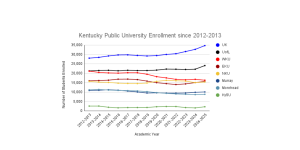Transfer, international students highlight spring enrollment
April 7, 2015
Recently released enrollment numbers show that the number of people enrolled at WKU has flatlined.
WKU’s spring enrollment stands at 18,445, according to a preliminary report provided by the Office of Institutional Research. The preliminary report stated enrollment was down 59 students, only 0.3 percent from last spring.
Brian Meredith, chief enrollment and graduation officer, said he felt good about this spring’s enrollment numbers, even though enrollment has been “flat” when compared to last year.
The current figure puts WKU in third place in enrollment compared to other public universities in the state. University of Kentucky boasts more than 28,000 students, and the University of Louisville comes in second with 22,300 students.
Due to the deadline for enrollment falling on the Board of Regents committee meetings on March 27, the enrollment number reported to the Kentucky Council on Postsecondary Education last Monday was 18,560 students. However, a more detailed final enrollment report would not be available until later this year, Meredith said.
The net loss of 59 students means a loss in budgetary funding for the university. In-state tuition, books, room and board for 59 students means a $938,000 loss to the university, using the estimated cost of attendance for 2014-2015. Given those same figures, a loss of 59 students for out-of-state students equals a $1.8 million loss to WKU. While this doesn’t seem like much in terms of the university’s $392 million budget overall, the $1 million to $2 million in loss could be redistributed given the fiscal plagues over the last several years’ budgets.
Smaller sectors of the student population saw gains in enrollment. International student enrollment is at 1,404 students, a 168 (13.6 percent) student increase from last spring, according to the preliminary report. Meredith credited WKU’s increased effort to reach international students. For example, there are methods dedicated to recruiting international students that involve working with students and governments abroad.
“We are investing in the students and it’s paying off,” he said. “And if you follow that over the next year… I think you’re going to see the trend continue to grow and go up.”
Most of the 482 transfer students that attend WKU come from a school within the Kentucky Community and Technical College System. WKU has a joint admissions agreement with seven of the 16 colleges, in which students can enroll in a KCTCS school and then transfer to WKU to finish their degree. Meredith said the joint admissions agreement was a significant factor that helped bolster the 380 transfer students that attended last spring.
“I think our joint admissions programs are now kicking in,” he said. “They’ve been in place long enough— multiple years now. We’ve invested a lot of time, human resource… into the joint admissions programs.”
Transfer students can range from those already in the workforce wanting to improve their skills, to veterans or to students who come back to college after dropping out, said Sharon Hunter, coordinator of College Readiness.
“There’s no such thing as a typical transfer student,” she said.
Nontraditional student enrollment is 2,885, which is a 5.9 percent or 180 student decrease from last spring. Meredith said due to the economy improving, many older adults are going back into the workforce. Hunter said WKU will remind students about the potential income a student can make by completing their degree, but said it’s a problem many colleges are dealing with.
“We are not alone in the drop of nontraditional students,” Hunter said.
In response to this, Meredith said WKU will begin to develop “adult accelerated programs,” which would allow nontraditional students to work and take classes simultaneously.
Meredith said he feels WKU is heading in the right direction for future enrollment figures, due to exploring new markets and keeping track of students already enrolled.
“Full steam ahead,” he said.















